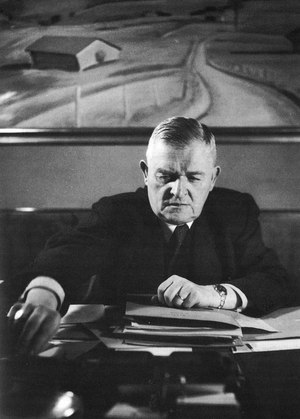
Unternavigation
Son of a teacher and farmer, Stampfli grew up in a middle-class family in Büren (Solothurn). After obtaining his ‘matura’ (high school leaving certificate), he studied at the Federal Institute of Technology (ETH) in Zurich before going on to earn his doctorate at the University of Zurich. He also gained a diploma as an insurance clerk in Germany. He married in 1917 and fathered three children. Stampfli’s political career began in 1908 when he worked as editor of the newspaper Oltener Tagblatt. In 1912, he was elected to the cantonal parliament of Solothurn for the Free Democrats and to the National Council in 1931. Stampfli joined the Von Roll foundry in 1921. As from 1929, he was director for commercial and social affairs, responsible for the company’s social security schemes in this position. During this time, Stampfli was also involved in the ‘Swiss Association of Old Age and Disability Pension Funds’ (SVUSAI), an association of private provision schemes. In his political capacity, he represented the interests of industry and opposed state intervention in the economy. In 1931, he supported the AHV and Edmund Schulthess' bill, while at the same time advocating the expansion of private old age provision. After his election to the Federal Council (1940), Stampfli – who had key contacts abroad – was responsible for economic negotiations with Germany and the Allies, as well as for the organisation of the wartime economy. Following the war, he prepared as head of the Federal Department of Economic Affairs the revision of the economic articles of the Constitution; these articles enabled state intervention in the economy and, in turn, involved economic associations in the political decision-making process. Having retired from the Federal Council at the end of 1947, Stampfli chaired the Board of Directors at Von Roll. As a father of a disabled daughter, he was also a vocal proponent of the integration of the disabled into the world of work.
As head of the Federal Department of Economic Affairs, which encompassed the Federal Social Insurance Office (BSV) at the time, Stampfli was responsible for the AHV, preparations for which had resumed at the end of the 1930s. In light of the experiences made during the First World War, he aimed at expanding unemployment provision in the first years of the war and provisionally rejected the use of surpluses from the Income Substitution Insurance for Militia Soldiers (EO) to set up the AHV. It took the pressure of various political forays for Stampfli to actively press ahead with the AHV in 1943. In his New Year’s address in 1944, he effectively announced the imminent implementation of a federal old age insurance scheme. One month later, the Federal Council appointed an expert commission to prepare the tenets of the AHV (pay-as-you-go financing through payroll contributions) with the close involvement of the BSV. During debates in experts’ commission and in Parliament, Stampfli succeeded in getting parties, economic associations and trade unions behind the project of creating a modest AHV scheme. Concurrently, the focus on the AHV had the result that options for a comprehensive expansion of social security – as presented by the British Beveridge Plan, for example – were barely discussed or even completely rejected in Switzerland. The model for a slim AHV scheme (consisting of ‘basic pensions’) provided enough room for of private-sector provision to expand; this was in line with the interest of the private pensions lobby Stampfli had represented during the interwar period. Voters voted in droves for the AHV proposal on 6th July 1947 – a matter of great satisfaction for Stampfli. The new social security system began operating on 1st January 1948.
Literatur / Bibliographie / Bibliografia / References: Hafner Georg (1986), Walther Stampfli 1884-1965. Leiter der Kriegswirtschaft im Zweiten Weltkrieg, bundesrätlicher Vater der AHV, Olten; Altermatt Urs (1991), Die Schweizer Bundesräte. Ein biographisches Lexikon, Zürich.
(12/2014)




